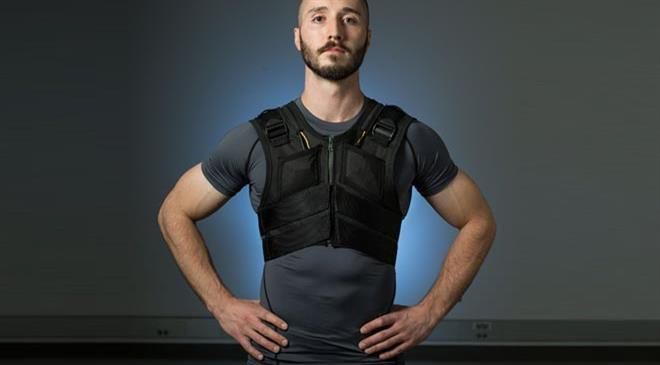TT: Which technology is used in smart innerwear?
The most important component was the insight gained through studying low back biomechanics. The device takes advantage of natural leaning and lifting biomechanics to offload the low back. The prototype was made using a sewing machine, 3D printing, and other traditional machining and manufacturing tools.
TT: How does it prevent back pain? Which aspects were considered during the design stage?
As a person leans forward or lifts an object, his trunk and hips flex. While wearing the smart undergarment, these motions stretch the embedded elastic bands that run parallel to the spine. So instead of low back muscles and ligaments doing all the work, the elastic bands share the load, taking away some of the stress on the tissues.
TT: What was the motivation behind developing smart innerwear?
I have a two-year-old son. He's heavy! And he's destroying my back. All the lifting and leaning involved in parenting a toddler is what initially got me thinking about low back pain, spine biomechanics and potential wearable tech solutions that could reduce stress on the low back. The major question was: how can we make a device that is both beneficial and practical for parents, as well as nurses, surgeons, caregivers, package handlers, construction workers, and others in daily life? Whatever we create should not interfere with other daily tasks, like sitting down or climbing stairs.
TT: The focus of the technology is not to treat those with existing back pain but to prevent it by reducing stress and fatigue on the low back muscles. Please elaborate.
Prevention is the name of the game. Among many potential causes of low back pain, we focus on a specific risk factor: pain or injury that can occur as a result of high (overloading) or repetitive (overuse) forces on the low back. By reducing load on the low back, we hope to lessen pain and injury risks for certain individuals. We have demonstrated the design's feasibility by showing that it can reduce low back muscle activity during lifting and leaning. Further research is needed to explore long-term impact on pain or injury.

TT: How economical are smart innerwear?
All the components could be fabricated inexpensively, using common textiles, materials and electromechanical components.
TT: What is the peculiarity of the textiles used in smart innerwear?
The prototype is made of common materials, such as nylon, canvas, Lycra and polyester.
Our goal with this initial study was to demonstrate feasibility. Future designs could be made of other, perhaps better, materials as long as they can serve the same biomechanical function in terms of a spring-like element that is sufficiently stiff, and materials that can handle the tensile forces applied to the garment.
TT: Your next idea is to use sensors embedded in the clothing to monitor low back stress. If it gets too high, can we automatically engage this smart clothing? Please share details.
As some of the details are confidential, all I can share is that we are looking into integrating sensing and potentially automating engagement of the smart clothing.
TT: What is new in the pipeline? Where and by when will it be made available?
My first priority is to refine the device and carry out further tests. To date, our research team has demonstrated the benefits of smart clothing in reducing low back muscle activity during lifting and leaning. But there is still a lot to explore. Additional research is needed to understand long-term effects on fatigue, pain and injury risks. A series of follow-up studies needs to be carefully designed and carried out. If their results are as exciting and promising as the results we have seen so far, then we may explore commercialisation.
TT: Tell us about your team.
Our team comprises mechanical engineering graduate students Erik Lamers and Matthew Yandell and undergraduates Lauren Branscombe, Josh Fleck and Juliana Soltys. Apart from me, the other faculty advisor is Aaron Yang, assistant professor of physical medicine and rehabilitation, with expertise in non-surgical management of low back and other musculoskeletal disorders.
TT: What is the future scope of smart clothing?
The future looks very promising with almost limitless possibilities. There is a lot of potential application to monitor or assist individuals, in ways that could reduce injury risks and improve health.
TT: How sustainable are smart wears? Is your smart underwear sustainable?
I have not thought about this. How sustainable are regular clothes? (RR)




